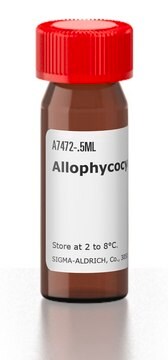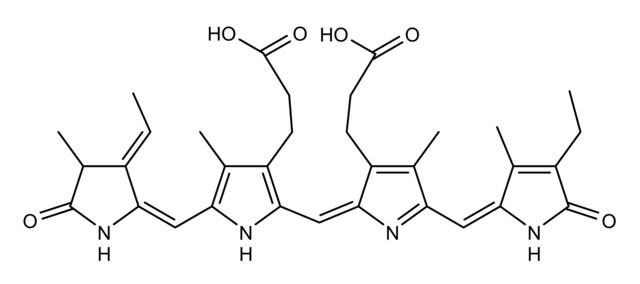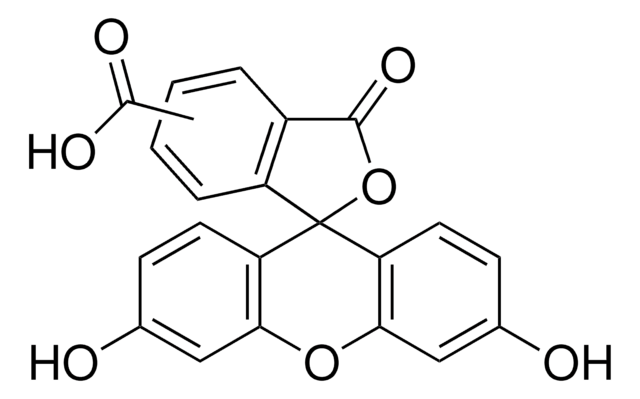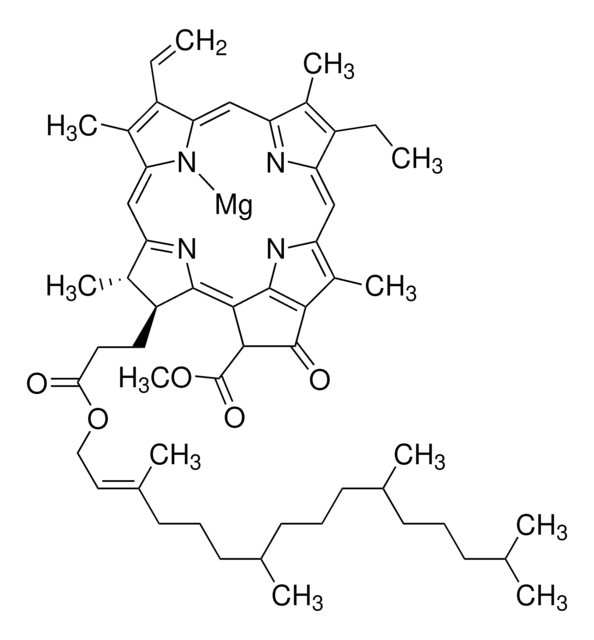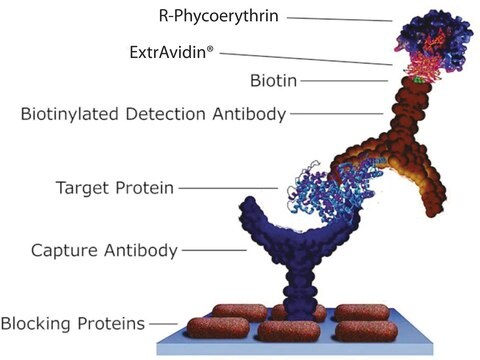52412
R-Phycoerythrin
BioReagent, passes test for gel electrophoresis
Synonym(s):
R-PE, phycobiliprotein
Sign Into View Organizational & Contract Pricing
All Photos(1)
About This Item
Recommended Products
product line
BioReagent
concentration
≥10.0 mg/mL (UV)
technique(s)
electrophoresis: suitable
fluorescence
λex 542 nm; λem 575 nm in 0.1 M phosphate pH 7.2
suitability
passes test for gel electrophoresis
storage temp.
2-8°C
Related Categories
General description
R-Phycoerythrin or R-PE is a fluorescent probe belonging to the group of phycobiliproteins obtained from macroalgae. R-Phycoerythrin (R-PE) is a protein acting as a photosynthetic accessory pigment in red algae (Rhodophyta). It is an oligomeric protein of 240 kDa, with 6 α (about 20 kDa), 6 β (about 20 kDa), and 1 γ (about 30 kDa) subunits. Phycobiliproteins are water-soluble light-harvesting proteins with a high fluorescent property.
Application
R-Phycoerythrin (R-PE) is useful in the laboratory as a fluorescence-based indicator for the presence of cyanobacteria and a variety of immunofluorescence applications. R-PE is a useful fluoroprobe in various electrophoretic procedures. R-Phycoerythrin (R-PE) proteins detect mercury ions in soil and groundwater samples. Phycoerythrin has been widely used in food, cosmetics, immunodiagnostics, and analytical reagents.
Analysis Note
The product is suspended in 150 mM sodium phosphate, 60% ammonium sulfate, 1 mM EDTA, 1 mM sodium azide, pH 7.0 and must be dialyzed against conjugation buffer or PBS before conjugation.A566/A280 >4.6, A620/A566 <0.03, A566/A498 <1.5
Storage Class Code
12 - Non Combustible Liquids
WGK
WGK 1
Flash Point(F)
Not applicable
Flash Point(C)
Not applicable
Personal Protective Equipment
dust mask type N95 (US), Eyeshields, Gloves
Certificates of Analysis (COA)
Search for Certificates of Analysis (COA) by entering the products Lot/Batch Number. Lot and Batch Numbers can be found on a product’s label following the words ‘Lot’ or ‘Batch’.
Already Own This Product?
Find documentation for the products that you have recently purchased in the Document Library.
Customers Also Viewed
Xuefei Sun et al.
Journal of chromatography. A, 1216(1), 159-164 (2008-12-17)
Electric field gradient focusing (EFGF) is a technique used to simultaneously separate and concentrate biomacromolecules, such as proteins, based on the opposing forces of an electric field gradient and a hydrodynamic flow. Recently, we reported EFGF devices fabricated completely from
Joerg Martini et al.
Lab on a chip, 12(23), 5057-5062 (2012-10-10)
We describe an optical detection technique that delivers high signal-to-noise discrimination to enable a multi-parameter flow cytometer that combines high performance, robustness, compactness and low cost. The enabling technique is termed "spatially modulated detection" and generates a time-dependent signal as
Kun Tang et al.
Biochimica et biophysica acta, 1817(7), 1030-1036 (2012-04-03)
Phycobilisomes, the light-harvesting antennas in cyanobacteria and red algae, consist of an allophycocyanin core that is attached to the membrane via a core-membrane linker, and rods comprised of phycocyanin and often also phycoerythrin or phycoerythrocyanin. Phycobiliproteins show excellent energy transfer
Radek Sachl et al.
Biophysical journal, 101(11), L60-L62 (2012-01-21)
Even though superresolution microscopy indicates that size of plasma membrane rafts is <20 nm, those structures have never been observed. Förster resonance energy transfer (FRET) is therefore still the most powerful optical method for characterization of such domains. In this letter
David Rizzo et al.
Cytometry. Part B, Clinical cytometry, 84(2), 125-132 (2012-12-12)
Flow cytometry is the reference technique for assessing ZAP70 expression, a marker of poor prognosis in CLL. One of the most common methods is to assess ZAP70 levels in CLL cells by calculating the ratio between ZAP70 mean fluorescence intensities
Our team of scientists has experience in all areas of research including Life Science, Material Science, Chemical Synthesis, Chromatography, Analytical and many others.
Contact Technical Service
